The Cultural Influence of the Yoruba Art Came From the Nok Culture and the Abu Culture
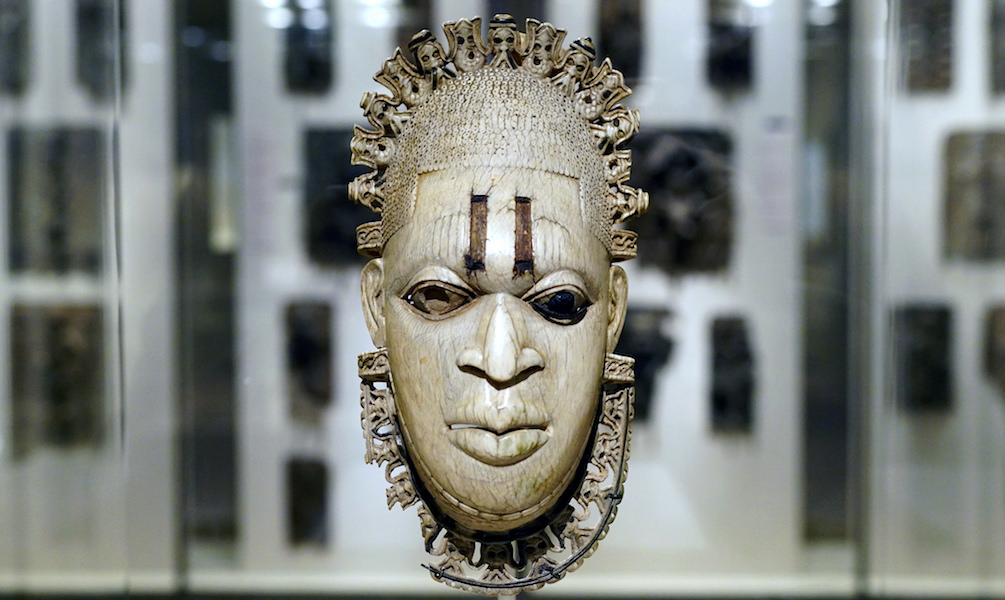
Queen Mother Pendant Mask (Iyoba), 16th century, Edo peoples, Court of Benin, Nigeria, ivory, atomic number 26, copper, 23.eight 10 12.7 x 8.iii cm (The Metropolitan Museum of Fine art)
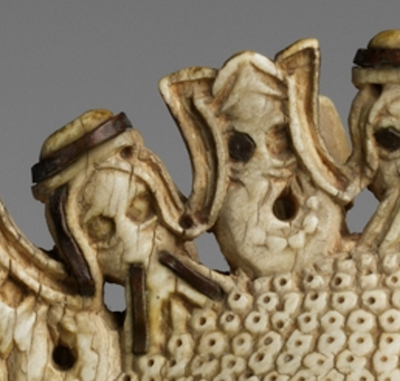
Portuguese explorers with beards and hats flanked by mudfish (item), Queen Mother Pendant Mask (Iyoba), 16th century, Edo peoples, Court of Republic of benin, Nigeria, ivory, atomic number 26, copper, 23.8 x 12.7 10 eight.iii cm (The Metropolitan Museum of Art)
Early on encounters with Europeans were oft recorded in African art. Look closely at the top of the mask above (and detail, left). Do yous see faces? These represent Portuguese explorers with beards and hats (flanked by mudfish) who visited the Benin Kingdom forth the west coast of Africa in the late 1400s. These explorers began to collect ivory which they referred to every bit "white golden."
Saltcellars similar the i below, commissioned by Portuguese officers and exquisitely produced by W African carvers, held precious tabular array salt. They would have been taken back to Portugal to exist displayed in curiosity cabinets. Today their carvings serve every bit a tape of the introduction of guns, Christianity, and European commodities to West Africa.
By the 1880s European powers were interested in Africa'southward resource, particularly mineral wealth and forests. Today, Africa is divided into 53 independent countries merely many scholars fence that the boundaries that carve up these countries are really artificial. They were drawn past Europeans at the Berlin Conference in 1884-85 without a single African present. They did not divide the continent past cultural or tribal region, merely instead created borders based on their own interests. The problems this created—separating families, language groups, trading partners, pastoralists from watering holes, etc.—are still very much at result today.
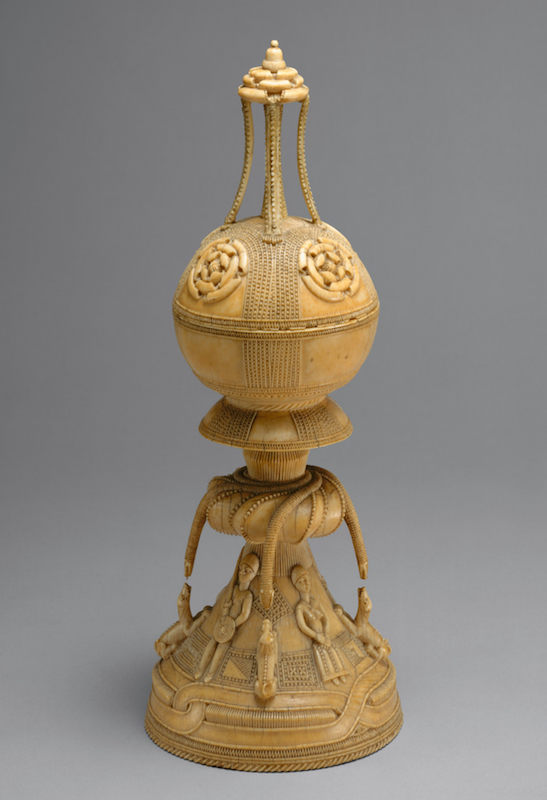
Lidded Saltcellar, Sierra Leone, Sapi-Portuguese, 15th-16th century, ivory, 29.8 cm loftier (The Metropolitan Museum of Art)
Movements in African History and Art
African cultures never existed in isolation—in that location was always move, trade, and the exchange of ideas. And logically African art is dynamic and has changed in grade, function, and meaning over time. Nevertheless, in the Western art market and in academia, there exists the concept of "traditional" African art. Normally this refers to "indigenous art traditions that were feasible and active prior to the colonization of Africa past European powers in the late nineteenth century. Implicit in the utilise of the word traditional is the assumption that the fine art which information technology describes is static and unchanging."[1] Many collectors and museum professionals identify far greater value on African objects created prior to colonization. For them, pre-colonial objects have an aura of an untainted, timeless past when artists only fabricated artworks for their ain communities unaffected by the outside world. These objects are besides often seen in opposition to work produced today using Western materials and conventions by artists who are engaged in a global discourse and who make works of art to be sold.
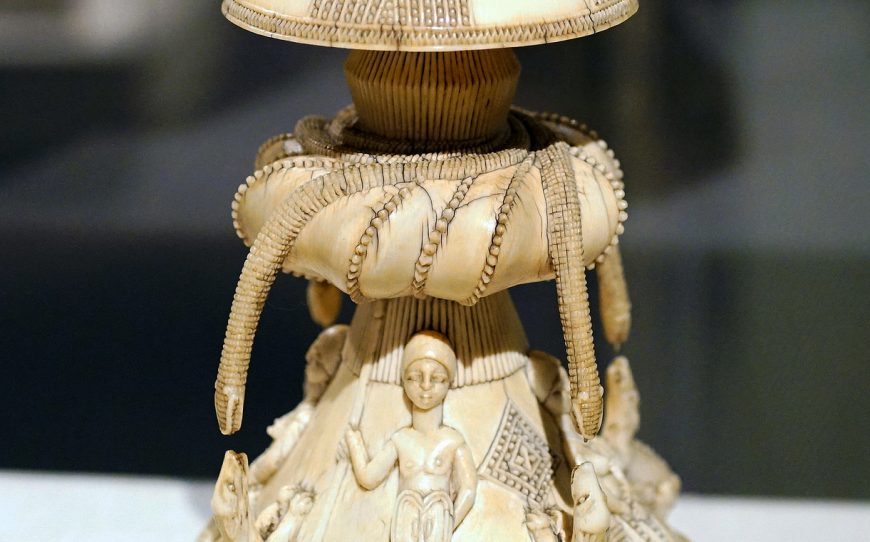
Lidded Saltcellar (detail), Sierra Leone, Sapi-Portuguese, 15th-16th century, ivory, 29.viii cm high (The Metropolitan Museum of Art)
In reality, some African art has always functioned as a article and artists have always drawn inspiration and materials from outside sources. While many auction houses and art museums clearly differentiate betwixt "traditional" African art created prior to the colonial period and artwork created during and after colonization, African art historians are starting time to dispel this simplistic division and instead, ask their audiences to recognize the continuity and dynamism of African art. Looking closer, scholars discover that specific historical moments had a profound affect on African communities and their art. During the slave trade and colonization, for example, some artists created work to come to terms with these horrific events—experiences that often stripped people of their cultural, religious and political identities.
The Transatlantic Slave Trade
One of the most dissentious experiences for many indigenous groups in Africa was the transatlantic slave trade. While slavery had long existed in Africa, the transatlantic slave trade constituted a mass motion of peoples over four and a half centuries to colonies in Due north and South America. X million people were taken to labor on cotton, rum, and sugar plantations in the new globe. Slavery coupled with the colonial experience had a profound effect on Africa and nevertheless causes strife. For example, Ghana has over fourscore ethnic groups and during slave raids, unlike groups were pitted against ane another—those living nigh the coast were involved in slave raiding in the interior in substitution for Portuguese and Dutch guns. Territorial disputes, poverty, famine, abuse, and affliction increased equally a outcome of the brutality of the slave merchandise and European colonization.
The Colonial Catamenia
With the collapse of the Atlantic slave trade in the 19th century, European imperialism connected to focus on Africa as a source for raw materials and markets for the goods produced by industrialized nations. Africa was partitioned by the European powers during the Berlin Conference of 1884-85, a meeting where not a single African was nowadays. The issue was a continent defined by artificial borders with little concern for existing indigenous, linguistic, or geographic realities.
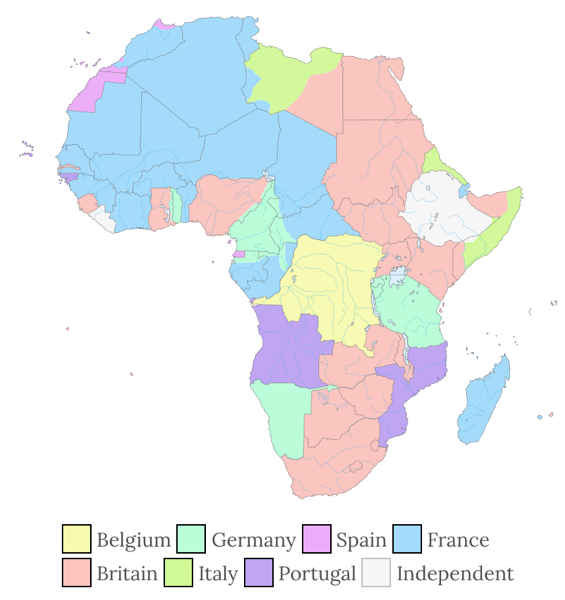
Colonial Africa in 1913
European nations claimed state in order to secure access to the natural resources they needed to support chop-chop growing industrial economies. Once European nations secured African territories, they embarked on a system of governance that enforced the provision of natural resources— with dire consequences for people and the environment.
Resistance to colonial rule grew steadily and between 1950 and 1980, 47 nations achieved independence; simply even with independence the problems associated with the slave trade and colonialism remained. The introduction of Christianity and the spread of Islam in the 19th and 20th century also transformed many African societies and many traditional art practices associated with indigenous religions declined. In addition, as imported manufactured goods entered local economies, hand-fabricated objects similar ceramic vessels and fiber baskets were replaced by factory-made containers. Withal, 1 way people made sense of these changes was through art and performance. Art plays a primal part, particularly in oral societies, as a way to think and heal. As African artists began catering to a new market of center-form urban Africans and foreigners, new art-making practices adult. Cocky-taught and academically trained painters, for instance, began depicting their experiences with colonialism and independence; every bit fine artists, their work is largely secular in content and meant to be displayed in galleries or modernistic homes (for case, see the piece of work of Cheri Samba, Jane Alexander, and Tshibumba Kanda-Matulu).
Globalization Today
The various and complex systems now at play as a result of globalization are having a profound impact on Africa. Some scholars contend that globalization will have even greater consequences than the slave trade and colonization in terms of population movement, ecology impact, and economic, social and political changes. Whatever the event, these stresses will be chronicled by the continent's many brilliant artists.
[1] Judith Perani and Fred T. Smith, The Visual Arts of Africa: Gender, Power, and Life Cycle Rituals (Prentice Hall, 1998) p. xvii.
Additional resources:
Afro-Portuguese Ivories on the Metropolitan Museum of Art's Heilbrunn Timeline of Art History
Nka Periodical of Gimmicky African Art
The Transatlantic Slave Trade Database
Source: https://smarthistory.org/african-art-and-encounters-with-europeans/
0 Response to "The Cultural Influence of the Yoruba Art Came From the Nok Culture and the Abu Culture"
Post a Comment